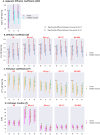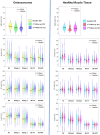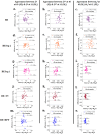Reproducibility of spatial penalty-based methodologies for intravoxel incoherent motion analysis with diffusion MRI
- PMID: 39354013
- PMCID: PMC11445472
- DOI: 10.1038/s41598-024-71173-0
Reproducibility of spatial penalty-based methodologies for intravoxel incoherent motion analysis with diffusion MRI
Abstract
Objective was to assess the precision and reproducibility of spatial penalty-based intravoxel incoherent motion (IVIM) methods in comparison to the conventional bi-exponential (BE) model-based IVIM methods. IVIM-MRI (11 b-values; 0-800 s/mm2) of forty patients (N = 40; Age = 17.7 ± 5.9 years; Male:Female = 30:10) with biopsy-proven osteosarcoma were acquired on a 1.5 Tesla scanner at 3 time-points: (i) baseline, (ii) after 1-cycle and (iii) after 3-cycles of neoadjuvant chemotherapy. Diffusion coefficient (D), Perfusion coefficient (D*) and Perfusion fraction (f) were estimated at three time-points in whole tumor and healthy muscle tissue using five methodologies (1) BE with three-parameter-fitting (BE), (2) Segmented-BE with two-parameter-fitting (BESeg-2), (3) Segmented-BE with one-parameter-fitting (BESeg-1), (4) BE with adaptive Total-Variation-penalty (BE + TV) and (5) BE with adaptive Huber-penalty (BE + HPF). Within-subject coefficient-of-variation (wCV) and between-subject coefficient-of-variation (bCV) of IVIM parameters were measured in healthy and tumor tissue. For precision and reproducibility, intra-scan comparison of wCV and bCV among five IVIM methods were performed using Friedman test followed by Wilcoxon-signed-ranks (WSR) post-hoc test. Experimental results demonstrated that BE + TV and BE + HPF showed significantly (p < 10-3) lower wCV and bCV for D (wCV: 24-32%; bCV: 22-31%) than BE method (wCV: 38-49%; bCV: 36-46%) across three time-points in healthy muscle and tumor. BE + TV and BE + HPF also demonstrated significantly (p < 10-3) lower wCV and bCV for estimating D* (wCV: 89-108%; bCV: 83-102%) and f (wCV: 55-60%; bCV: 56-60%) than BE, BESeg-2 and BESeg-1 methods (D*-wCV: 102-122%; D*-bCV: 98-114% and f-wCV: 96-130%; f-bCV: 94-125%) in both tumor and healthy tissue across three time-points. Spatial penalty based IVIM analysis methods BE + TV and BE + HPF demonstrated lower variability and improved precision and reproducibility in the current clinical settings.
Keywords: Intravoxel incoherent motion; Precision; Quantitative comparison; Reproducibility; Spatial penalty based IVIM method.
© 2024. The Author(s).
Conflict of interest statement
The authors declare no competing interests.
Figures





Similar articles
-
Radiologists' Rating for Comparative Qualitative Assessment of Intravoxel Incoherent Motion Using Novel Analysis Methods.J Comput Assist Tomogr. 2024 Mar-Apr 01;48(2):263-272. doi: 10.1097/RCT.0000000000001540. Epub 2023 Nov 24. J Comput Assist Tomogr. 2024. PMID: 37657076
-
Quantitative Analysis of Intravoxel Incoherent Motion (IVIM) Diffusion MRI using Total Variation and Huber Penalty Function.Med Phys. 2017 Nov;44(11):5849-5858. doi: 10.1002/mp.12520. Epub 2017 Oct 11. Med Phys. 2017. PMID: 28817196
-
Lung Cancer: Short-Term Reproducibility of Intravoxel Incoherent Motion Parameters and Apparent Diffusion Coefficient at 3T.J Magn Reson Imaging. 2018 Apr;47(4):1003-1012. doi: 10.1002/jmri.25820. Epub 2017 Jul 25. J Magn Reson Imaging. 2018. PMID: 28741732
-
Bayesian intravoxel incoherent motion parameter mapping in the human heart.J Cardiovasc Magn Reson. 2017 Nov 6;19(1):85. doi: 10.1186/s12968-017-0391-1. J Cardiovasc Magn Reson. 2017. PMID: 29110717 Free PMC article.
-
Non-invasive intravoxel incoherent motion MRI in prediction of histopathological response to neoadjuvant chemotherapy and survival outcome in osteosarcoma at the time of diagnosis.J Transl Med. 2022 Dec 27;20(1):625. doi: 10.1186/s12967-022-03838-1. J Transl Med. 2022. PMID: 36575510 Free PMC article.
References
-
- Koh, D., Dm, K. & Dj, C. Diffusion-weighted MRI in the body: Applications and challenges in oncology. Am. J. Roentgenol.188, 1622–1635 (2007). - PubMed
-
- Le Bihan, D. et al. Separation of diffusion and perfusion in intravoxel incoherent motion MR imaging. Radiology168, 497–505 (1988). - PubMed
-
- Le Bihan, D. What can we see with IVIM MRI? Neuroimage15, 56–67 (2019). - PubMed
-
- Iima, M. & Bihan, D. L. Clinical intravoxel incoherent motion and diffusion MR imaging: Past, present, and future. Radiology278, 13–32 (2016). - PubMed
-
- Koh, D., Collins, D. J. & Orton, M. R. Intravoxel incoherent motion in body diffusion-weighted MRI: Reality and challenges. Am. J. Roentgenol.196, 1351–1361 (2011). - PubMed
MeSH terms
LinkOut - more resources
Full Text Sources

